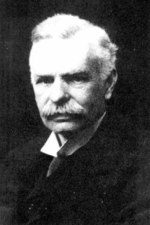Richard Dixon Oldham
| Richard Dixon Oldham | |
|---|---|

Richard Dixon Oldham
|
|
| Born |
31 July 1858 Dublin |
| Died | 15 July 1936 (age 77) |
| Nationality | United Kingdom |
| Fields | geologist |
| Known for | measuring Earth's core; separate arrival of seismic phases |
Richard Dixon Oldham FRS (/ˈoʊldəm/; 31 July 1858 – 15 July 1936) was a British geologist who made the first clear identification of the separate arrivals of P-waves, S-waves and surface waves on seismograms and the first clear evidence that the Earth has a central core.
Born on 31 July 1858 to Thomas Oldham, a Fellow of the Royal Society and geologist, Oldham was educated at Rugby School and the Royal School of Mines.
In 1879 Oldham became an assistant-superintendent with the Geological Survey of India, working in the Himalayas. He wrote about 40 publications for the Survey on geological subjects including hot springs, the geology of the Son Valley and the structure of the Himalayas and the Ganges plain. His most famous work was in seismology. His report on the 1897 Assam earthquake went far beyond reports of previous earthquakes. It included a description of the Chedrang fault, with uplift up to 35 feet and reported accelerations of the ground that had exceeded the Earth's gravitational acceleration. His most important contribution to seismology was the first clear identification of the separate arrivals of P-waves, S-waves and surface waves on seismograms. Since these observations agreed with theory for elastic waves, they showed that the Earth could be treated as elastic in studies of seismic waves.
...
Wikipedia
